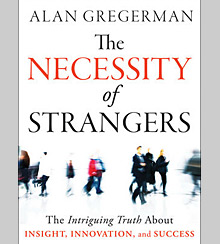Small Talk, Big Results
Keith Ferrazzi, author of Who’s Got Your Back: The Breakthrough Program to Build Deep, Trusting Relationships That Create Success—and Won’t Let You Fail, introduces a passage on the value of connecting with co-workers from The Necessity of Strangers: The Intriguing Truth about Insight, Innovation, and Success, by Alan Gregerman.
“We have nothing in common.”
We’ve all heard (and probably used) this phrase, but it’s not actually true. We are all connected, we all have things in common. We just need to engage in conversations that reveal our similarities.
It can be hard to break through the silos that separate us, but the effort is well worth it. We’re social creatures. We thrive by forming strong, intimate bonds with one another, in both our personal and our professional lives. Yet, anthropologically, we are hardwired to be ready to fight or flee from someone not of our tribe—a state of mind that obviously has a very negative effect on our ability to innovate together. Small talk quiets that reptilian response of our brain.
In the excerpt below from The Necessity of Strangers, Alan Gregerman shows how quickly two people can find not just one thing, but many things, in common. Some are meaningful, others are frivolous, but they all serve to bring those two individuals together. And once they connect, it becomes easier for them to connect with others, leading to what Gregerman calls a “culture of conversation.” Through shared interests, former strangers can form authentic relationships that encourage deep, meaningful collaboration.
Knowing that, how can you not use Gregerman’s technique the next time you meet someone?
—Keith Ferrazzi
An excerpt from chapter 6 of The Necessity of Strangers: The Intriguing Truth about Insight, Innovation, and Success
Have you ever taken the time to really get to know the people you work with?
I don’t mean just your closest friends at the office (assuming you have close friends where you work), the other people who work in your department, or the people across the hall or in the next set of cubicles, but all of the other absolutely wonderful and remarkable folks in all of the other departments who may seem to exist simply to make your life miserable. Or the ones who don’t even make your life miserable but are simply names and titles posted on doors. If you did try to get to know them, you might find that:
a. You actually like them.
b. They have interests and talents beyond their job descriptions.
c. You have something in common with them.
d. All of the above.
This question—Have you ever taken the time to really get to know the people you work with?— isn’t on the SAT, the Myers-Briggs, or any other assessment instrument or personality profile, but it might be more important to your success than all of those tools. For the past several years I have been challenging companies and organizations around the world to think about this question and its relevance to their short- and long-term success—and then to have conversations with each other and, in the process, create “cultures of conversation” in which they ask all of their people to commit to discovering the humanity, genius, and possibilities in their coworkers and their entire organizations. They are to do this two people at a time by making a simple and powerful human connection through a simple exercise that lays the foundation for greater collaboration.
To date, over twenty thousand people in different walks of life, positions, and levels, and across companies and cultures, have been part of my experiment. All I do is ask people to pair off with someone they don’t know very well or don’t know at all. Then I give them a very easy assignment: have a five-minute conversation in which you can talk about anything you like except work. Anything else. You can talk about your hobbies and interests, your family, where you grew up, where you went to school, what you eat for breakfast, the books you like to read, or even the fact that you were raised by wolves. Anything. Except work. And, because metrics are important, during the five minutes you have to come up with a list of at least ten things the two of you have in common. Ten things about you that are shared by another person from your company or organization whom you hardly know.
What generally happens is this: after a moment of hesitation, a quiet room begins to buzz with energy and connections—all based on having a world of things in common. Things like those in the following list:
The Power of Ten Things
A simple starting point for reinventing collaboration. . .
–Our family, our birth order, and the number of children, grandchildren and/or siblings we have. . .
–Where we come from and the places we’ve lived. . .
–Where we went to school and what we studied. . .
–Music we listen to or instruments we play. . .
–Favorite foods and whether or not we like to cook. . .
–Travel and our favorite places to get away. . .
–Hobbies and things we like to do in our free time. . .
–Volunteering we do to make the world a better place. . .
–Our favorite season or seasons of the year. . .
–Our spiritual beliefs or religion and their role in our lives. . .
–Our pets. . .
–The sports we play or love to watch. . .
–The cars we drive. . .
–Things we like to read and watch on TV. . .
–People we admire. . .
–Our favorite movies of all time. . .
–Our favorite colors. . .
–Whether we are neat or messy, late or on time. . .
–And any number of other areas of interest that come up when two people make the time to connect.
This exercise is actually rather easy to do. In fact, I bet that each of us could be paired with any other person in the world and—assuming that language was not a barrier or that, if it was, we had an interpreter in the seat behind us—we would, in a few short minutes, find at least ten things we had in common. Ten things that would begin to build a bond. Ten things that make others a lot more like us than we ever imagined. Ten reasons why we would be more inclined to collaborate with them than not. Ten things that would make almost all of our stereotypes about them and the role they play drift away. Ten things that could spark new ideas and perspectives, based on our shared interests outside of work, that could be brought to bear in our work lives and efforts to make our companies and organizations more remarkable.
This is the power of ten things.
Once you’ve done the exercise with one colleague, then you could do it with another, and another, until you become part of creating a culture of conversation that is a far more powerful driver of collaboration than anything else that you or your company could do. Collaboration takes place face-to-face between humans who are open to connecting and sharing the things they know.
And then, now that some of the barriers have been reduced, you continue these conversations, to include the world of work, what other people do, the things they know best, the things they would like to know more about, the things that concern them most, and the way they look at problems and opportunities. New conversations begin to identify areas in which you can work together to think in new and more collaborative ways, and also allow you to think about who else to involve in your efforts. In a company or organization filled with strangers, commit to making everyone a real friend and colleague by wandering around and having conversations that matter.
—Alan Gregerman
Reprinted with permission from the publisher, Jossey-Bass, a Wiley brand. Copyright © 2013 by Alan Gregerman.



